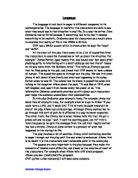The language used in ‘Blood Wedding’ is extremely significant in fully understanding the emotion and atmosphere that Lorca is trying to portray. The first symbolic use of language in the play is the names used for the different characters, instead of giving each character a personal name and identity, Lorca gave them archetypal and symbolic qualities, for example the mother, the bride and the wife. This therefore makes the one character with a name differentiated and individualised, almost cut off from the other characters, in a league of his own. Leonardo is a greatly symbolic name, suggesting the strength of a lion, a sense of fire and passion is created, and there is also the thought of the Spanish meaning of the name, which are lion and I burn. These meanings that you get just from the name and the Spanish meanings have a strong significant link to the building of Leonardo as a character and the type of person he is.
In Act one Scene two, the lullaby that opens the scene is extremely effective and contrasting to the manner in which the previous lines were delivered. The mother-in-law’s earliest dialogue is extremely symbolic and helps to convey the situation of the Wife and Leonardo, the water is expressed as precious and sacred and the horse is conveyed as isolated and numb. From the powerful use of symbolism we can deduct that Lorca may be trying to portray the Wife and Leonardo’s relationship in this particular song. The water being the Wife and the Horse Leonardo, “Of the great big stallion, wouldn’t drink the water deep.” (pg9) The horse’s refusal to drink the water could convey Leonardo’s refusal to stay with his Wife and Love her. The mother-in-law’s words are very bitter and ruthless, “Horsey’s hooves are red with blood, Horsey’s mane is frozen, Deep inside his staring eyes, A silver dagger broken.” (pg10) it seems that she is conscious that Leonardo is hiding something and resents him because of that, Leonardo to them is numb inside, yet their ideas of him are of complete contrast when we see him towards the end of the play with the Bride, he is alive and outspoken of his feelings. There is no connection between the Leonardo that the mother-in-law and Wife see, to the Leonardo that the Bride sees. The Wife’s dialogue in this song shows two contrasts between her feelings for Leonardo and her feelings for her baby. “Oh, the great big stallion wouldn’t drink the water deep, pain as sharp as coldest ice,” (pg11) the words spoken of Leonardo greatly contrast with the words for her baby “Baby has a nice soft pillow. Baby’s quilt so fine to feel.” (pg11) This shows the sensitive nature of the Wife towards her child yet the pain that she is experiencing because of Leonardo. Lorca is portraying the Wife’s feelings in a creative and artistic way, giving the audience a chance to empathise with her. The use of verse in this scene captures the darkening mood and almost throws a shadow over the scenes that follow, pervasive the central characters. It appears that verse, used by a number of characters throughout the play, is used as a tool to highlight and portray true feelings, adding dramatic tension to the scenes. As we discover later in the play, Leonardo's passion will eventually lead to his death, the metaphor of the hoarse is seen once again in Act Two Scene One, where the Servant is speaking to Leonardo "You’ll kill the animal racing him like that." to which Leonardo retorts "If he dies, it dies!"(pg24) Again the horse is being used as a representation of Leonardo; this description could be a symbol for Leonardo’s racing heart and emotions that eventually kill him.







